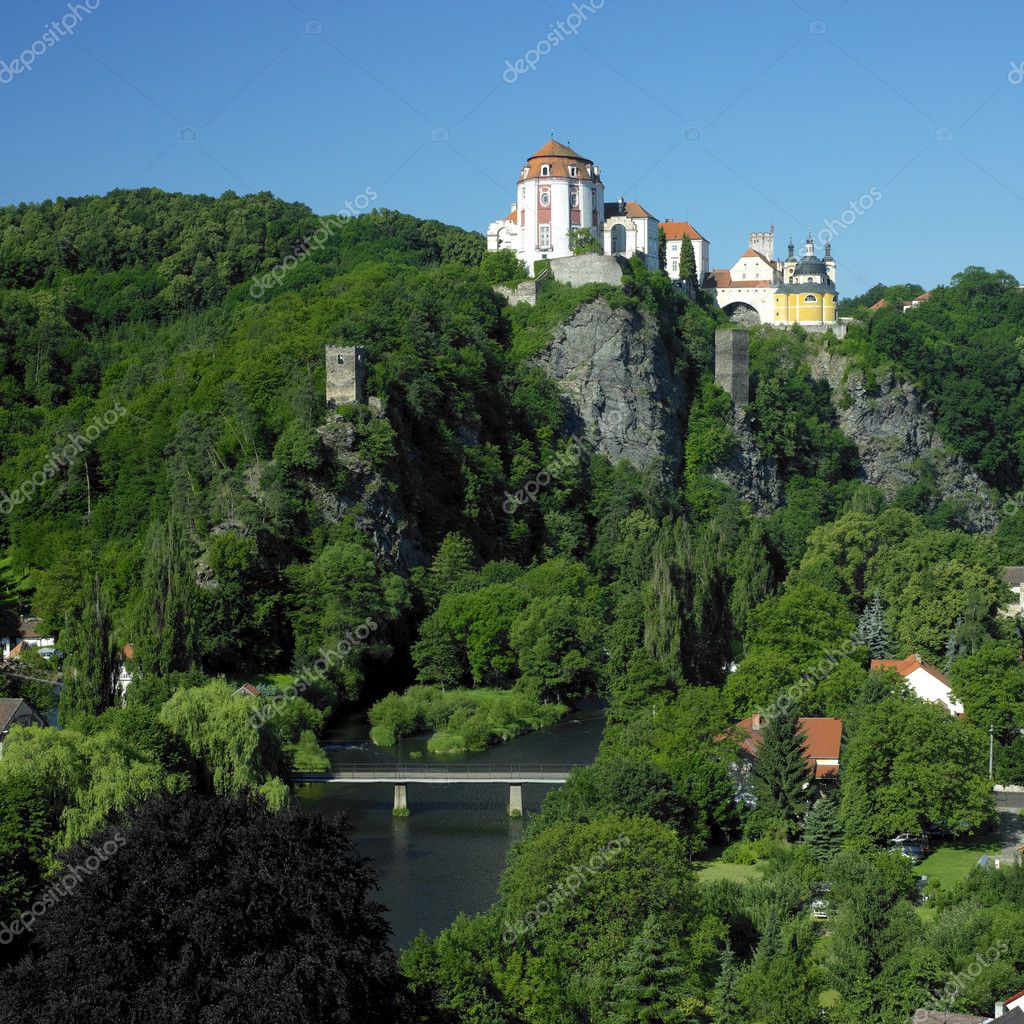Vranov nad Dyjà Chateau
The Vranov Castle ( German: Frain ) belongs to the municipality Vranov in Okres Znojmo in Moravia (Czech Republic). It lies on the Thaya, 18 km west of Znojmo in Vöttauer hills.
History
The Vranov Castle stands on the site of a princely castle that served the country's defense against Austria. It was built by Duke Břetislav and first recorded in the year 1100 in the Chronica Boemorum.
The castle and manor Vranov was located since 1323 in the possession of Henry of Lipa and came to the Lords of Lichtenburg, which included the neighboring castles Bítov and Zornstein. Since the beginning of the 16th century it was owned by Arkleb of Boskowitz, John of Pernštejna, Sidonius of Lomnitz, Wolf Kraiger of Kraigk and the men of Dietrich stone.
1614 were purchased from Althann castle and lordship Frain by Wolf Dietrich, whose possessions were confiscated by the emperor because of his participation in the uprising after the Battle of White Mountain. Since 1629 they belonged to Johann Ernst of Scherfenberg and after 1665 the Count Starhemberg. Among them, the castle Frain was again changed structurally.
1680 acquired the Imperial Count Michael Johann von Althann castle and lordship Frain. He led the rebuilding of the castle into a stately baroque castle according to the plans of the Viennese court architect Johann Bernhard Fischer von Erlach. They were implemented 1687-1695. The result is, inter alia, the ancestral hall with an oval ground plan and a dome. The stills significant Althann for wall niches created by the Viennese sculptor Tobias Kracker, the frescoes Michael Rottmayr. 1699-1700 was the chapel of the Holy Trinity, in which is located the tomb of Althann family. The paintings in the chapel created by Ignaz Heinitz Heinzenthal. Althanns daughter Maria Anna, born Pignatelli, prompted by the 1722 construction of the three-winged castle building, whose design probably came from the court architect Anton Erhard Martinelli. Under their rule, two groups of statues were erected in the courtyard, probably Lorenzo Mattielli created. They are a gift from the Emperor Charles VI. be.
Michael Joseph of Althann, which since 1774, the rule was Frain, prompted further modifications of the castle. The castle was decorated with artistic high quality stucco, the walls with precious wallpaper and paintings. Before the ancestral hall, a terrace was designed and decorated with triumphal arches, in which busts were erected by Socrates and Pallas Athena. With these modifications indebted to Michael Joseph of Althann so much so that his possessions in 1793 fell into bankruptcy. From the bankrupt acquired the Prague lawyer Johann Lilienborn castle and lordship Frain. He ordered the construction of a castle park with artificial grottoes, statues and watercourses. The stables and carriage shed at the entrance of the castle go back to him.
Beginning of the 19th century acquired the Polish aristocrat Stanisław Mniszek the estate. He caused to the castle facade changes in the Gothic Revival style and the wall paintings in the western wing of the castle. Among the Mnischek and related with them Stadnický, where the castle belonged since 1876, a castle library was founded and promoted theater and music and performed in the castle.
After the Adam Stadnický 1939 lost the castle during the time of the Protectorate by confiscation, it acquired Gebhard of the Wense / Mörse. He was expropriated after the end of World War II, and the castle passed into state ownership. In the 1970s there was a major renovation of the castle.
In addition to the ancestral hall and the chapel additional rooms can be visited and the interior design from the 18th and 19th centuries. Also on display are exhibits of Frainer ceramic manufactory.
In 1993, the castle served as a filming location for the film The Emperor's New Clothes with Harald Juhnke. Similarly, the action thriller Triple X with Vin Diesel was shot largely on Vranov.










